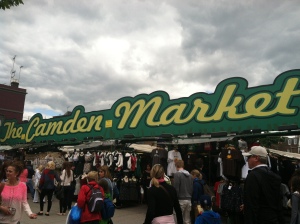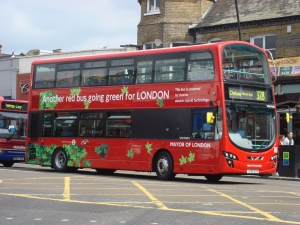Each week during my study abroad experience I chose a unique topic providing a deeper look into art, retail, media, waterways & sustainability within the amazing city of London complete with media & photos.
Week One: Art
C215’s Back, Back Again
Brick Lane may be famous for two things in particular, curry & color. Brick Lane’s street art is one of the most fascinating aspects of this bustling area where many Bangladeshi fill the streets with amazing aromas of curry. It is hard to walk through the streets and not take a few seconds to appreciate all the art that decorates the walls. Coming from North Philadelphia, street art has many different associations. I think of the huge murals of African American culture produced by teams of volunteers and also the disappointing “tagging” of many signs surrounding the area. At Brick Lane the feeling is much more artistic however. I feel that the atmosphere welcomes the bright colors and that the people there respect and have a genuine love for the creativeness of the street artists as well as a deep rooted trust that they will provide art and not vandalism.
On one of my trips to Brick Lane I was particularly moved by a certain piece of street art that depicted a young girl with much too serious of a face. After doing some research about the artists that frequent the area around Brick Lane I was able to identify it’s artist as C215, aka Christian Guémy a French artist from Paris. His work is similar to that of Banksy because of the use of stencils but the feeling he evokes is much different. C215 is very unique in that most of his pieces use lots of color but still manage to portray subject matter that society has forgotten about. His art strives to make people stop and take a closer look at the real people he depicts first and his amazing skills second.
After doing some more research I was pleasantly surprised to find out that C215 is no stranger to the Brick Lane area. The piece that caught my eye is a newer piece done this year adding on to several that he did when he visited London a year ago back in July 2011. The blog I visited hunted down a remarkable seven other street art pieces in the Brick Lane area done by C215 himself. I think that he enjoys returning to Brick Lane because the people clearly appreciate his work and his skills as a talented street artist.
Link to Pictures from C215’s July 2011 Visit to London
Examples of C215’s pieces from my visit to Brick Lane
Week Two: Retail
London’s Markets
One of the best parts of London is finding unique markets all around the city including Brixton Market, Borough Market, Spitalfield Market, Camden Market, and Portobello Market. Each of these markets provide a distinct atmosphere and shopping experience tailored to particular price ranges and merchandise. More times than not these markets provide items at cheaper prices than you would find in a regular store and also come with a certain charm of finding something special among a variety of stands and the ability to barter always leaves you feeling like you got the best bargan keeping shoppings returning week after week.
Brixton Market provides all types of products including vegetables, fruits, meats, fish, apperal, jewlery, household items, and other collectable goods. Each stand is set up side by side down Electric Avenue making the most of the tiny space available. Each stand is also a licensed member since the Brixton Market Traders’ Federation opened the markets in November of 2011. This particular market is very unique because it is the only trader-operated London street market. During my visit was particular amazed by the variety of exotic fruits available. It was also refreshing to see ingredients that were typical of the ones used in dishes in restaurants in the Brixton area. I believe this helps both the market traders and the local businesses owners because it unites the community with one common factor, good fresh food.
Vegetable Stand at Brixton Market
Another great food market that stole my heart was Borough Market. The first time I ventured there it was not very exciting and only had a few stands open. I was determined however to see it in all its glory on Saturdays when it is most busy. When I headed back the second time I was blown away how the atmosphere changed. The entire area was booming with people of all ages and ethnicities all looking for fresh meats, cheeses, olives, and authentic prepared meals. Each stand was eager to give patrons a taste test because they were all very confident in their fresh foods. I didn’t even have to buy anything to leave full from so many vendors offering me food left and right! Most foods were priced reasonably which made it the epicenter of local lunch breaks.
Fresh Olives at Borough Market
Spitalfields Market was yet another market that I wanted to spend hours at. This particular market catered toward the crafty shopper looking for unique hand made presents and jewelry. This market, like Borough Market, is more active during Saturdays. I had to go back twice to make sure I got the full experience and sure enough the Saturday I went I stayed for hours. The prices at this market were much higher than the previous ones but for a good reason. The level of craftsman ship at each stand was outstanding and I even got to have a conversation with a first time stand owner pursuing his dream of selling screen printed t-shirts, postcards, and posters.
Old Slides I bought at Spitalfields Market
Another great place to get gifts at a cheaper price is Camden Market located near Camden High Street. This market reminded me much more of ones that can be seen in New York. It was jam packed with little room to weave through the tent stands. The items at Camden are much cheaper and even allows for bartering to bring down the original price. The saying you get what you pay for is a good way to describe these markets however. Most of the items are a lesser quality, but great for small gifts all in one place.
Crowded Camden Market
Lastly, Portobello Market was my favorite non-food market. This market has much steeper prices than the ones mentioned above but also has a wider variety of goods, in a nice area, and made with a high quality. The main stands that I loved in Portobello were the antiques but they came with a hefty price tag. The overall atmosphere of this market was my favorite because it was more laid back and spaced out allowing people to browse more slowly and comfortably.
Antique Tins at Portobello Market
All of London’s markets provide a tailored atmosphere perfect for any shoppers needs. It was great to try them all out and figure out which ones suited me best and I think that this is why the markets are so popular in London. Everyone can enjoy a market experience if they find the one that fits their shopping style, needs, and price range.
Sources: Brixton Market | Borough Market | Spitalfields Market | Camden Market |Portobello Market
Week Three: Media
ASA
British media takes pride in providing its citizens with quality information. Although with this information comes the advertising that helps pay for the media projected. An important aspect of regulating advertising in the UK is the Advertising Standards Authority (ASA). This organization is independent from the Government and advertising industry but has the legal authority to make sure all ads in the UK are legal, decent, honest, and truthful. The ASA is very important to UK because it regulates what is acceptable to be shown to consumers. An informed team at the ASA works on investigating advertising complaints as well as suggesting solutions for unacceptable ads to be changed.
There is a variety of ways in which the ASA accepts complains from anyone in the UK. They allow complains via an online form, telephone call, or a written letter. During this process however it is important to include information about where you saw the advertisement, what time, and what your specific complaint is about. This information helps a team of specialist analyze the complaint and judge if further action needs to be investigated to declare the fate of that advertisement. An interesting concept is that anyone can make a complaint. During our information session at the ASA it was interesting to hear that there are some people who are considered regulars and often send several complaints. I believe that many of these repeat complainers do so because they enjoy that they are kept anonymous and also simply they have too much free time on their hands!
After the complaint is filed and reviewed it is either dismissed or sent to an Investigative Executive which researches the advertisement and sends it to review by the ASA Council, an independent jury, who makes the final decision as to if the Advertising Codes have been broken. I feel that this process is long but very well structured because it uses a hierarchy process. It is amazing at the amount of complains come across the desks each year that need to be sorted and investigated. The ASA reported that they dealt with 31,458 complaints last year and that 4,591 of them were changed or withdrawn in 2011.
Of all the advertisers who receive a letter from the ASA stating their ad does not comply with rules they most often change the ad or decide to scrap it all together. However, those who don’t are penalized legally and publicly. Legally, the ASA can issue alerts to media outlets to not accept ads from a particular offender and they can also withdrawal trading privileges such as discounts from media outlets as well. In my opinion the more disastrous consequence is the public backlash that could result. Living in an age of increased media, particularly social media, having a brand or service put out an unlawful ad could destroy their brand image. News travels faster today than ever before and many people rely on peers opinions of products or services which are often expressed on social media sites such as Facebook and Twitter.
Ultimately the ASA protects the people of the UK from any offensive, untruthful, or inappropriate advertising and is an important aspect of the history of British media. There will always be controversy of what is too much control over an industry but after hearing Investigative Executives from the ASA and researching it further I believe that they are important to have and also do not step over the boundaries of being too controlling. One of the major aspects that lead me to this decision is the genuine helpfulness they express when an ad has breeched code. They offer a suggestion as to how the ad can be changed which I believe provides evidence that the ASA is truly just focused on providing a good media experience for the people of the United Kingdom.
Sources: ASA
Example of controversial ASA complaint that was cleared
Example of controversial ASA complaint that was banned
Week Four:
London Transport Goes Green
London took on the huge task of providing the world with the most sustainable Olympics they have ever seen, but London also carries that love for sustainable development to the transportation systems within the city. The Transportation for London (TfL) states they are “maximizing the environmental, social and economic benefits of our operations and minimizing the negative impacts.” For such a large city it is amazing to see the dedication TfL puts into providing efficient yet sustainable way for people to travel.
One aspect of the future plans for the City of London is to reduce CO2 emissions by 60% in 2025 from the 1990 levels. The TfL has already taken measures to provide a flood management plan, a tunnel cooling program, and changed bus specifications. As an iconic symbol of London, the red double decker buses may seem like a gas guzzling giant but now the TfL has invested in diesel-electric hybrid buses which save 40% CO2, fewer air emissions, and are even quieter. These new buses are fueled by a mix of ordinary diesel and interesting enough an electric motor. This motor collects energy that is created by regenerative braking whenever the bus comes to a stop. This energy is then stored in a battery pack and transferred to the motor. This step toward sustainable design is a huge one for the London scene. There is practically no place in London you can go without being too far from a double decker. It is no wonder the city decided to focus on the buses first!
The buses are not the only public transportation going green however. The London Underground has also begun taking the necessary steps to decrease its carbon footprint to reach the 2025 goals. The main emission causing activities of the Underground are Greenwich Power station gas and oil consumption, gas consumption at stations, depots, and offices, and consumption of purchased electricity. In 2010 the Underground signed up ten stations to participate in the 10:10 climate change campaign which helped to cut emissions in as quickly as 12 months by 10%. To reach these goals efficient lighting and the Northern Line’s control center was replaced with a “green” energy efficient roof. They also noted that escalators will be switched off during non-peak times and lights will be turned off as well when not needed saving 70,000 pounds and over 500 tones of CO2 per year. After traveling on the Underground almost everyday for a month I now realized the changes I had seen make sense. When I first arrived I remembered some lines such as the Picadilly having one of the two upward escalators turned off on multiple occasions. Now with the Olympics in full force all escalators are running to help with crowd control.
After researching the plans that are already in effect for reducing London’s CO2 emissions I have a new found respect more so now when traveling through London. It is amazing that such a large transportation system has already began to see gradual success toward a higher goal. I predict that more cities will use London’s plans as a reference as more cities hopefully take the pledge to work toward greener transportation.
Energy Efficient Bus
Sources: Transportation for London | London Underground goes greener










